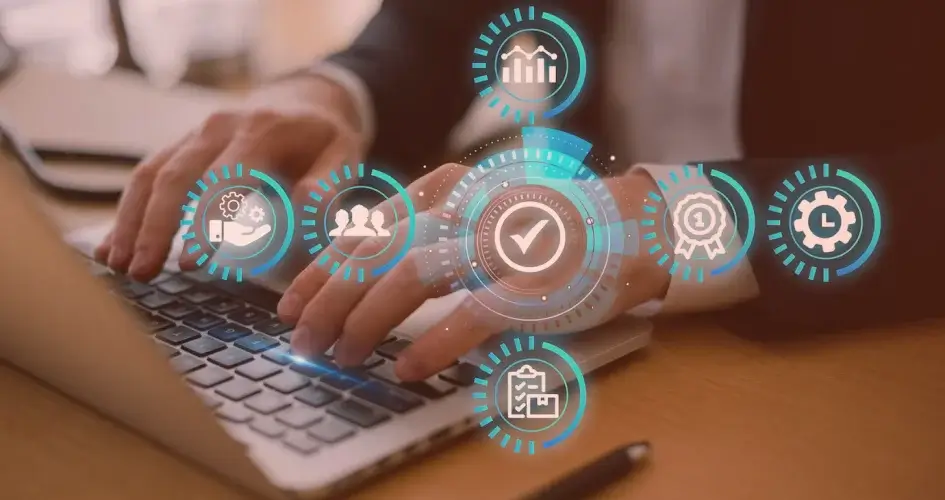Legacy modernization challenges are a reality for many businesses still relying on older software applications.
Yet, migration is only a partial remedy.
Overcoming legacy issues requires a balance between innovation and risk management.
That’s why understanding the nuances of legacy system application migration is critical to determining your business’s most effective modernization strategy.
In this blog, we’ll guide you to the challenges often faced by doing this migration with complete steps to mitigate this process.
5 Main Challenges of Legacy System Migration in Software Development
Developers commonly use programming languages like COBOL or RPG for legacy systems.
In fact, the banking sector constructs 43% of its systems using COBOL.
They are crucial but may not meet current customer or business requirements.
Despite their limitations, the deep integration of these legacy systems into business processes makes them hard to replace.
Fortunately, there’s a solution: migrating these legacy applications to modern platforms.
Such a migration offers the tools and capabilities to enhance operational efficiency and improve user experiences.
Understanding the legacy modernization challenges is crucial for businesses looking to update their software infrastructure.
1. Costs
Legacy modernization challenges often include managing the high costs associated with system overhauls.
There are also several additional expenses, such as:
- training staff on new systems
- potential downtime during the transition
- the cost of data migration.
Additionally, companies face indirect costs like temporary reductions in productivity as employees adjust to the new system.
2. Technical Specifications
One of the most significant legacy modernization challenges is ensuring compatibility with new technologies.
Legacy systems are built on outdated technology that may not be compatible with modern software and hardware.
This incompatibility can lead to significant challenges, for example:
- data migration
- system integration
- user interface redesign.
For instance, data stored in an old format might need to be converted to a new format, which can be time-consuming and error-prone.
Also, integrating new applications with legacy systems often requires extensive customization, which can be costly and complex.
To tackle the complexities of legacy modernization, many companies opt for software development services providers for their comprehensive solutions.
3. Risks of Project Delays
Legacy modernization challenges can extend beyond technology, impacting organizational culture and workflows.
Project delays are a common issue in legacy system migration, resulting from underestimating the complexity of the task.
Delays can also occur if the team encounters unanticipated compatibility issues requiring additional time to resolve.
These setbacks increase the project’s cost and disrupt business operations, leading to lost revenue and reduced customer satisfaction.
4. User Experience
Legacy systems have a user interface that employees are accustomed to, and any changes can affect their efficiency and comfort.
During migration, there might be a period when users need to work with a hybrid of legacy and new systems, which can be confusing and reduce productivity.
After migration, users must adapt to the new system, which might require training and adjustment time.
5. Data Loss or Corruption
Data stored in a legacy system might not be directly compatible with the new system, requiring conversion or transformation.
The process can inadvertently lead to lost or incorrectly converted data, resulting in errors and inconsistencies.
Furthermore, the risk is compounded if the legacy system contains a large volume of data or if the data is particularly sensitive or critical to business operations.
A thorough assessment of these legacy issues is essential before deciding on a modernization strategy.
3 Types of Legacy System Migration
Explore the different approaches to legacy system migration if you plan on doing this.
Rehosting (Lift and Shift)
Rehosting involves moving an existing application to a new hardware environment or cloud platform without modifying its code, features, or functions.
This approach is usually chosen for its speed and cost-effectiveness, as it requires minimal changes to the application.
However, while rehosting can be a quick fix, it doesn’t address any underlying issues with the application’s architecture or design.
Refactoring (Making Small Changes)
Refactoring is akin to renovating a house room by room, improving each part without tearing down the entire structure.
You only make small changes to the application’s code to improve its structure and efficiency without altering its external behavior or functionality.
Refactoring helps optimize legacy applications to utilize new cloud-based environments better, enhancing performance and reducing costs while minimizing legacy issues caused by disruption to operations.
Rearchitecting (Making Big Changes)
Rearchitecting means significantly changing the application’s architecture to utilize modern technologies and platforms fully.
It includes altering the code to align with modern, cloud-native architectures, which can significantly improve scalability, performance, and flexibility.
Completely changing the architecture benefits applications that must respond more to changing market demands or technological advancements.
The Severe Risks of Keeping the Legacy Systems
While migrating has several challenges, keeping the old legacy system produces more risks.
Compatibility Issues and Data Silos
Legacy systems run on outdated software that doesn’t integrate well with newer technologies.
This lack of integration leads to data silos.
It means information is isolated and cannot be easily accessed or shared across different departments or systems.
These legacy issues hinder efficient data analysis and decision-making.
Moreover, the inability to integrate with new technologies can limit your company’s ability to adopt innovative solutions, such as cloud computing or advanced analytics.
Maintenance Costs
As these systems age, they require more resources to maintain.
Finding software maintenance & support specialists who understand and can work with older technologies becomes increasingly difficult and expensive.
Additionally, older systems are more prone to breakdowns and require frequent repairs and patches, which adds to the overall maintenance cost.
In the retail sector, companies allocate 58% of their technology budget to upkeep outdated systems.
Furthermore, as vendors stop supporting older technologies, finding spare parts or software updates becomes challenging, increasing the risk of system failures and security vulnerabilities.
Low Performance
Old systems continually suffer from low-performance legacy issues.
They were designed for a different era, with less data volume and fewer user demands.
As businesses grow and data volume increases, these systems struggle to keep up, leading to slower processing times and inefficiencies.
This sluggish performance can affect every aspect of a business, from customer service to internal operations, as employees wait longer for systems to respond.
Security and Compliance
Older systems aren’t equipped to handle modern security threats, making them vulnerable to cyber-attacks.
These legacy issues exist because many legacy systems no longer receive vendor security updates.
Also, legacy systems may not comply with new data protection laws as regulations evolve, potentially exposing businesses to legal risks and fines.
Lack of Support
Vendors focus on newer products as technology advances, reducing or discontinuing support for older systems.
A lack of support means businesses using legacy systems are on their own regarding troubleshooting, repairs, and updates.
The situation can leave businesses in a precarious position, especially when facing system failures or needing to adapt to changing business needs.
How to Overcome Legacy System Migration Challenges
Implement the following tips to overcome the legacy modernization challenges effectively.
1. Thoroughly Assess Your Current Legacy System
The first step in minimizing legacy issues is a comprehensive assessment of your current setup.
It involves evaluating the existing system’s capabilities and limitations and how it aligns with your business objectives.
This assessment should also include an analysis of:
- The system’s architecture
- data flow
- integration points with other systems.
Understanding these elements helps identify potential risks and areas requiring modernization attention.
Also, it’s essential to consider the financial implications of maintaining the current system versus the potential benefits of modernization.
2. Pick the Right Legacy System Modernization Strategy
Choosing the appropriate strategy for legacy system modernization should be based on the assessment findings and align with your business goals.
Several strategies are needed, such as rehosting, refactoring, or rearchitecting.
The choice of approach should consider factors such as:
- cost
- time
- business impact
- future scalability
A clear roadmap and timeline for the modernization process is essential, ensuring minimal disruption to your business operations.
3. Be Careful When Choosing A Partner
Choosing the right partners and technology solutions can mitigate legacy modernization challenges.
Look for a partner with a proven track record in handling similar projects.
They should have expertise in old and new technologies and understand your industry’s specific needs.
A good partner will offer technical expertise and guide you through the process, helping minimize risks and ensure a smooth transition.
Evaluate their approach to project management, communication style, and ability to understand and align with your business objectives.
It’s also wise to check references and past project outcomes to gauge their reliability and performance.
4. Get Everyone Involved
Legacy system modernization impacts various parts of your organization, so involving all relevant stakeholders is vital, including:
- The IT team and representatives from business units
- Teams from the operations
- Other departments affected by the change
Their insights can provide valuable perspectives on how the system is used and what improvements are needed.
Involving everyone also helps manage change more effectively, promoting understanding and buy-in from different parts of the organization.
Regular meetings and updates can keep everyone aligned and informed about the progress and any challenges encountered.
5. Schedule Thorough Testing
Testing is a crucial part of the modernization process to mitigate legacy issues.
It ensures the new system functions as intended and data integrity is maintained throughout the transition.
Develop a comprehensive testing plan, including:
- Unit testing
- System testing
- User acceptance testing.
Also, test the new system’s functionality, performance, and security aspects.
You can involve end-users in the QA testing process, as they can provide practical insights into how the system performs in real-world scenarios.
Scheduling regular testing phases throughout the project can help identify and address issues early, reducing the risk of significant problems during go-live.
Conclusion
In addressing the legacy modernization challenges, your business must embrace a strategic approach that aligns with your business goals.
Some strategies include:
- Carefully evaluating your existing system
- Selecting a suitable modernization strategy
- Involving the right partners and team members
- Ensuring thorough testing to avoid future complications
Remember, the goal is to replace old systems and enhance your business’s efficiency, security, and competitiveness in a constantly evolving technological environment.
With a thoughtful approach, the transition from legacy systems can be smooth and rewarding, leading to improved performance and growth opportunities.
Feeling overwhelmed?
Intelivita can help smooth your mitigation process.
We specialize in Flutter app development, offering a streamlined approach to modernizing legacy systems.
Our expertise in this open-source framework enables us to create high-quality, cross-platform applications with a single codebase.
We provide comprehensive services, including mobile app development for Android and iOS, design, migration, integration, and post-launch support.
Our solutions focus on delivering a native-like user experience, ensuring security, and maintaining reliability.
With Intelivita, businesses benefit from cost-effective, expertly crafted applications that enhance user engagement across multiple platforms.





